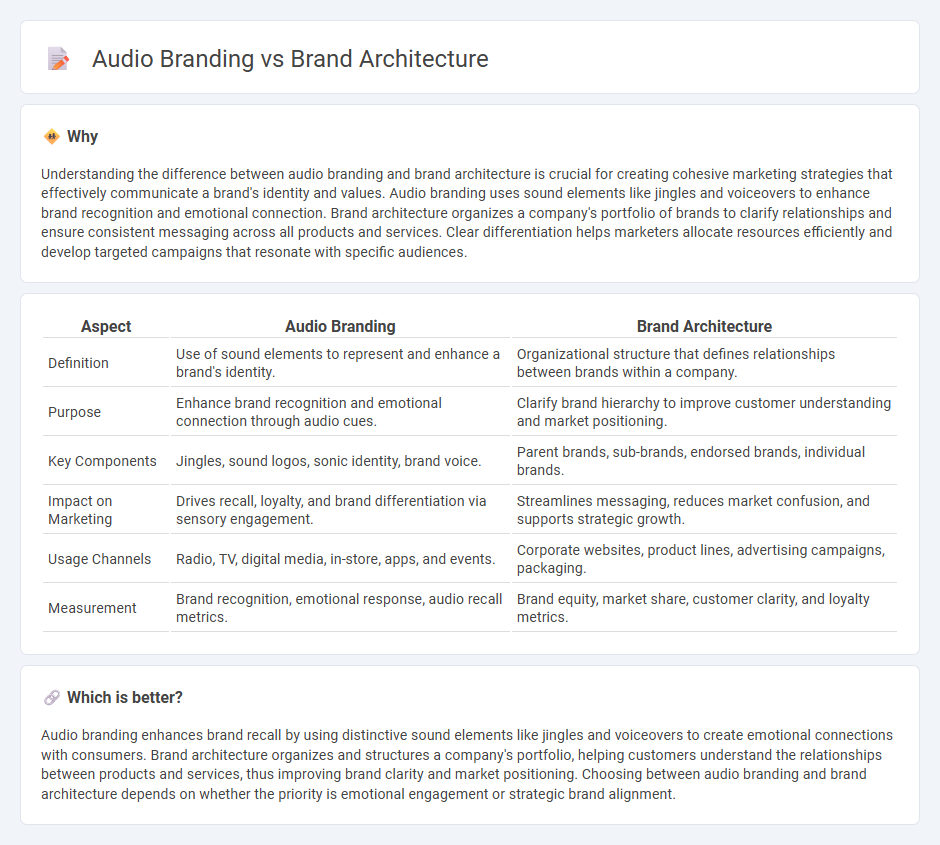
Audio branding enhances brand recognition by using distinctive sounds to create emotional connections with consumers, influencing brand recall and loyalty. Brand architecture organizes a company's portfolio, clarifying relationships between different brands or products to optimize market positioning and customer understanding. Discover how integrating audio branding with strategic brand architecture can elevate your marketing effectiveness.
Why it is important
Understanding the difference between audio branding and brand architecture is crucial for creating cohesive marketing strategies that effectively communicate a brand's identity and values. Audio branding uses sound elements like jingles and voiceovers to enhance brand recognition and emotional connection. Brand architecture organizes a company's portfolio of brands to clarify relationships and ensure consistent messaging across all products and services. Clear differentiation helps marketers allocate resources efficiently and develop targeted campaigns that resonate with specific audiences.
Comparison Table
| Aspect | Audio Branding | Brand Architecture |
|---|---|---|
| Definition | Use of sound elements to represent and enhance a brand's identity. | Organizational structure that defines relationships between brands within a company. |
| Purpose | Enhance brand recognition and emotional connection through audio cues. | Clarify brand hierarchy to improve customer understanding and market positioning. |
| Key Components | Jingles, sound logos, sonic identity, brand voice. | Parent brands, sub-brands, endorsed brands, individual brands. |
| Impact on Marketing | Drives recall, loyalty, and brand differentiation via sensory engagement. | Streamlines messaging, reduces market confusion, and supports strategic growth. |
| Usage Channels | Radio, TV, digital media, in-store, apps, and events. | Corporate websites, product lines, advertising campaigns, packaging. |
| Measurement | Brand recognition, emotional response, audio recall metrics. | Brand equity, market share, customer clarity, and loyalty metrics. |
Which is better?
Audio branding enhances brand recall by using distinctive sound elements like jingles and voiceovers to create emotional connections with consumers. Brand architecture organizes and structures a company's portfolio, helping customers understand the relationships between products and services, thus improving brand clarity and market positioning. Choosing between audio branding and brand architecture depends on whether the priority is emotional engagement or strategic brand alignment.
Connection
Audio branding enhances brand architecture by creating consistent sonic elements that reinforce brand identity across products and services. Sound logos, jingles, and voice-overs establish emotional connections, improving brand recall and differentiation within a structured brand hierarchy. Integrating audio branding strategically supports cohesive messaging and strengthens overall brand equity.
Key Terms
**Brand Architecture:**
Brand architecture defines the strategic framework that organizes a company's portfolio of brands, products, and services to establish clear relationships and enhance market positioning. It involves creating a cohesive structure such as monolithic, endorsed, or pluralistic models that align with business goals and customer perception. Explore how effective brand architecture drives consistent messaging and business growth by learning more about its core principles and applications.
Brand Hierarchy
Brand architecture defines the structured relationship between a company's brands, sub-brands, and products, establishing a clear brand hierarchy that enhances customer understanding and loyalty. Audio branding uses sound elements such as jingles, voiceovers, and sonic logos to reinforce brand identity and emotional connection within this hierarchy. Discover how mastering both brand architecture and audio branding can elevate your brand's market presence.
Sub-brands
Brand architecture structures sub-brands to maintain clear relationships and consistent messaging within a parent brand's portfolio, enhancing market clarity and customer recognition. Audio branding uses distinct sound elements, such as jingles or sonic logos, to differentiate sub-brands audibly, reinforcing brand identity and emotional connection. Discover how integrating brand architecture with audio branding can elevate your sub-brands' impact.
Source and External Links
Brand Architecture: Types & Best Examples - Brand architecture is the hierarchy of brands within an organization, often structured around a strong master brand that dominates sub-brands which share visual identity with minor modifications, as seen in models like the branded house exemplified by Fedex and Apple.
The Complete Guide to Brand Architecture - Brand architecture is the framework that illustrates the relationships between a company's master brand and its sub-brands, with the master brand being the most recognizable and often appearing on all products and services, such as Apple with its Apple Music and iPhone sub-brands.
The complete guide to brand architecture - Brand architecture defines the different levels within a brand and provides a hierarchy explaining relationships between products and services, guiding internal growth and delivering clarity to consumers, with structures like the branded house where the parent brand identity strongly cascades to all sub-brands, e.g., Fedex.
 dowidth.com
dowidth.com